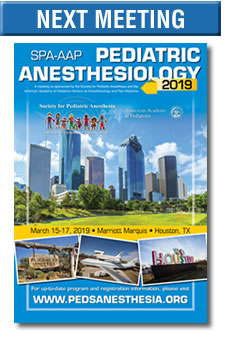meeting reviews
Kids Matter - Big Innovations for Little Patients
Reviewed by Erin Williams, MD, FAAP
Texas Children’s Hospital
Baylor College of Medicine
Can you imagine a future where cystic fibrosis no longer exists? Or, try to envision a time when sickle cell anemia is a disease of the past. The potential for the eradication of these conditions, along with the early diagnosis then obliteration of other debilitating illnesses that alter the quality of life for so many children and adults, may very soon become a reality.
Dr. Steven L. Schafer, Adjunct Professor of Anesthesiology, Perioperative and Pain Medicine from Stanford University, gave the audience a glimpse of the seemingly endless possibilities that exist for pediatric medicine during his keynote address Kids Matter - Big Innovations for Little Patients. Dr. Schafer began his eloquent talk with an invitation to attend the “Swimming with Sharks” sessions. These sessions are FAER-sponsored and allow inventors and innovators in the field of anesthesiology to sell or pitch their ideas in a mock investor’s forum. This was encouraged given that there are several opportunities to address clinical challenges seen in pediatric anesthesiology. From multifrequency oscillatory ventilation, being developed by David Kaczka, MD, PhD at the University of Iowa, to transabdominal fetal monitors being constructed by Neil Ray, MD at the University of California, Davis, to touchless monitors by Art Wallace, MD, PhD at University of California, San Francisco, the possibilities for technological innovation in pediatric anesthesia exist.
Dr. Schafer also discussed the utility of neuroimaging studies such as functional MRI, EEG, and functional NIRS in the analyses and diagnosis of behavioral disorders such as autism. Given that the assays currently utilized have poor reproducibility and thus difficulty in diagnosing intellectual difficulties and or behavioral disorders in those under the age of two. Bosl and colleagues were able to show 100% sensitivity and specificity for autism diagnosis at age three by utilizing EEG data that in some cases was collected as early as six months of age for some. Having the ability to diagnose deficiencies early will allow earlier intervention and potentially better behavioural or intellectual outcomes.
DNA sequencing technology was discussed at length. Dr. Schafer reminded the audience of the definition of a palindrome. A palindrome is any word that is spelled the same forwards and backwards. Examples of palindromes are words such as “racecar,” or these sequence of words “madam I’m Adam,” to name a few. This crash course in grammar was just a segue to understanding the key concept behind the mechanics of bioengineering.
The audience had a brief review of the history of genome sequencing; in 1987, Dr. Yoshizumi Ishino and colleagues broke the DNA sequence and discovered a palindrome in the sequence. To understand how palindromes relate to bioengineering and therapeutics, Dr. Schafer introduced the acronym – “CRISPR.” This six-letter term is the foundation of how DNA is changed or modified at the molecular level to allow resistance or protection from various diseases. CRISPR stands for Clustered Regularly Interspersed Palindromic Repeats, a term coined 2002 by a group from the Netherlands; this simply put is a series of repeating bases found in DNA.
The main concept was that bacterial DNA could be “infected” with a virus, which subsequently incorporated with the bacterial DNA, resulting in a form of protection from or resistance to future viruses. Other researchers such as Jennifer Doudna also discovered which proteins were involved in the cutting of DNA. Fast-forwarding from the bacteria model to the human cell, the same resistance or protection has been demonstrated. This understanding of where DNA can be modified at the base pair level is precisely gene editing.
CRISPR allows gene editing by utilizing a protein called Cas 9. This CRISPR/Cas 9 editing has been used in human cells and has the potential to help eradicate a variety of conditions that we see today such as Diabetes Type 1, Sickle cell anemia, glucose-6-phosphodiesterase deficiency (G6PD deficiency), Huntington’s, and Alzheimer’s. The implications of modifying DNA can have immeasurable benefits when curing disease. Dr. Schafer showed a video of several patients diagnosed with various forms of spinal muscle atrophy (SMA) who received gene therapy; it was amazing to see the ability to have head control, sit up, and even walk with assistance, in children who would otherwise be unable to do so. The medical benefits of gene editing seem innumerable; however, Dr. Schafer reminded the audience as with any scientific discovery once must use this with thoughtful caution. Just because we can, does not always mean we should. Everything we do has consequences and as scientists and clinicians we must remain mindful of that.
Currently, there are hundreds of companies working on human gene therapy. Whether we can use gene editing to wipe out cancer or Duchenne’s muscular dystrophy, we must recognize that CRISPR/Cas9 biotechnology is here and diseases of today may soon be a thing of the past.
Sources
- Barrangou R, van Pijkeren JP (February 2016). "Exploiting CRISPR-Cas immune systems for genome editing in bacteria". Current Opinion in Biotechnology. 37: 61–8. https://doi.org/10.1016/j.copbio.2015.10.003
- Bosl WJ, Tager-Flusberg H, Nelson CA. EEG Analytics for early detection of autism spectrum disorder: a data driven approach. Scientific Report. May 2018, 1;(8)6828.
https://doi.org/10.1038/s41598-018-24318-x - Ishino Y, Shinagawa H, Makino K, Amemura M, Nakata A. Nucleotide sequence of the iap gene, responsible for alkaline phosphatase isozyme conversion in Escherichia coli, and identification of the gene product. Journal of Bacteriology. Dec 1987, 169(12): 5429-33. https://www.ncbi.nlm.nih.gov/pmc/articles/PMC213968/
- Jinek M, Chylinski K, Fonfara I, Hauer M, Doudna JA, Charpentier E (August 2012). "A programmable dual-RNA-guided DNA endonuclease in adaptive bacterial immunity". Science. 337 (6096): 816–21.
https://doi.org/10.1126/science.1225829 - Mojica FJ, Díez-Villaseñor C, García-Martínez J, Soria E (February 2005). "Intervening sequences of regularly spaced prokaryotic repeats derive from foreign genetic elements". Journal of Molecular Evolution. 60 (2): 174–82. https://doi.org/10.1007/s00239-004-0046-3






